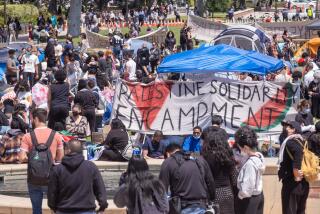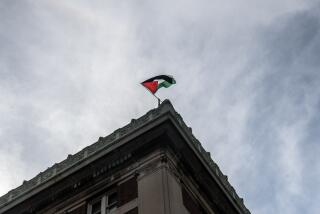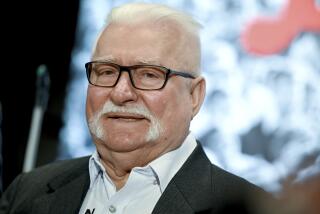Solidarity Forever : A WAY OF HOPE<i> by Lech Walesa; (Henry Holt: $19.95; 325 pp., illustrated) </i>
- Share via
Solidarity burst upon the Polish scene in August, 1980. It and Lech Walesa, the spritely, mustached electrician who was to become its head and symbol, managed to prove that the rules of the game in communist societies were not what they had once seemed to be.
Strikes were held and concessions made. An independent trade union was organized in the face of Communist Party claims to be the “vanguard of the proletariat.” An entire society began to change. Even after the flood of change was dammed up by a siege of the Polish military against its own people in the declaration of “martial law,” Solidarity and Walesa continued to be forces the regime had to contend with, concede to, and face down.
Scholars and citizens alike, in West and East, watched the men and events of the Solidarity era with fascination. For this was truly a movement of the common people--who proved they were not so common. No person better personifies this than the man who was to be the prime leader of Solidarity, Lech Walesa. After all, electricians seldom come from nowhere to lead a movement of more than 10 million workers, forging new tactics and forcing concessions not with the threat of violence but by the aroused will of the society.
“A Way of Hope” is purportedly the autobiography of that man--the archetypical Pole, the peasant turned worker, the child of the communist era in Poland, the union leader, the compelling speaker, the undefeatable hero, and the Nobel Prize winner. In fact, however “A Way of Hope” is less an autobiography than a report about Everyman in the Poland of the Solidarity era. Walesa claims for himself, in this book, a kind of omnipresence at every event and on every podium that no mortal could have had. For those who wish to look objectively at the dynamics that made the Solidarity era and martial law the phenomena they were, this is extremely frustrating. But for those who want to be swept into the turmoil of those 15 months in Poland and their prelude and aftermath, Walesa’s poetic license makes the story all the more compelling and understandable.
Walesa’s account of Solidarity and its battles puts him at the center of every event and every decision. He was, from the picture he paints, the only real leader: “Nothing was easy, but I really felt, however arrogant it may sound, that if anything was to be achieved, it was up to me to achieve it.” Walesa was the one with the answers. Walesa did not make mistakes, others did when they did not listen to him. All wisdom sprang from him. It was he, after all, who was “able to point to a third way in those situations where everybody says there are only two.”
Like Walesa, those he quotes see him as Poland’s hero. One Solidarity activist who traveled with Walesa reminisces, “When Lech made his speeches it was as if he was riding the crest of a wave rolling in from the crowd and was riding it like a surfer. He was able to express what each one of us felt deep inside.” What the others who risked and fought to make this wave roll forward did or thought thus pales into insignificance.
There is no denying that Walesa was a hero and that he was the symbol of Solidarity for all the world. He acknowledged this to the crowd gathered below his apartment window the day he received the Novel Peace Prize: “I see this as a prize for us all, as a reward to each of us who wished to attain the truth by following the course of nonviolence and common understanding.”
But, tragically, by simplifying and personalizing the story of the birth and struggles of the first independent trade union in the communist bloc into a story that revolves around him, Walesa loses much of the reality and vibrance of the events. Solidarity was never a simple union. It was, most often, a happening of people from all walks of life seeking, in every way they could, the dignity of power over their own lives. Walesa was far from their only or unquestioned leader.
No one idea or person could or did rule. On virtually no issue could Solidarity claim to be solid. Instead, until its last days above ground and even underground, Solidarity’s victory was the independence of its members not only from their communist rulers but from any one telling them how to act or think. Lech Walesa had to struggle for his leadership. He defied his own governing board when he met with Roman Catholic Primate Jozef Glemp and Gen. Wojciech Jaruzelski to try to come to an agreement that could “save Poland.” All other accounts of the politics of Solidarity in those last days before the declaration of martial law paint a picture different from Walesa’s self-portrait: The governing board did not trust Walesa to negotiate as an individual. They would agree only to go as a body of 40 equals to talk with the general and the primate.
The true story of Solidarity is not, then, really the story of Walesa. It is a tapestry made of multitudes of equally dedicated and often equally fascinating characters. In writing of himself, Walesa gives these other actors barely a brush stroke. The early intellectual leaders of the opposition as well as those who were moved to come over to Solidarity as advisers receive barely a mention. Left out are the other worker heroes from Solidarity’s early days as well as its days underground such as Zbigniew Bujak, the fugitive leader of Solidarity who was so well protected by a network of supporters that he was virtually untrappable, and Anna Walentinowicz, the dedicated laborer whose firing earned her such support from her fellow workers in the Gdansk shipyards that they listed her reinstatement a major demand alongside such major demands as the recognition of independent trade unions, a freer press, and the right to strike.
In his compulsion to tell his story, Walesa tells us only in passing of his talks with the Pope whom he so adored, saying virtually nothing of their secret meeting in 1983 when John Paul had returned to his embattled homeland with a message of peace and patience. The rumors that the Pope tried to mediate between the martial law rulers and Walesa will have to remain rumors. Walesa’s chief observations are only that there was an atmosphere of “openness and simplicity” and that he “suddenly noticed the Pope’s large feet . . . Surprisingly, his steps were steady, measured, and confident.”
Curiously, the men who sat on the other side of the negotiating table from Walesa seem to be more memorable. In spite of the heavy shroud of censorship kept over top-level Polish politics in the ‘70s, Walesa claims to know what the leaders were thinking and how they were jockeying for power. Jaruzelski comes out as a desperate but savvy politician who had studied Walesa’s presumably short military record as a corporal in the Polish army. The government officials with whom Walesa negotiated are, for him, men whose careers would rise or fall by their success against Solidarity. Surprisingly, give the hatred between the leaders and the led in Poland, they are also men he wishes would come to his side.
In setting all others aside, Walesa does little to answer the key questions about the events that make up the Solidarity era. That he was there and that he sensed the movement beginning does not tell us why demands for an independent trade union began in Gdansk among the well-paid shipyard workers two months after strikes had begun to convulse Poland or how it was that after 12 months of trying to avoid directly threatening the Soviet Union, the Solidarity National Congress passed a resolution calling for workers all over the Soviet bloc to join.
Just as the preparations and high politics of the first independent trade union congress in the Soviet bloc got barely a word, likewise the puzzle of the final hours before martial law. If the leaders of Solidarity knew that the telephone lines were cut and troops were moving on Gdansk the night of December 12, 1981, why did they leave the safety of the shipyards and venture home or to their hotels? Since Walesa claims he knew the rulers’ plans and views, how could an entire movement of 10 million people be surprised and swept underground by soldiers and police when martial law was declared at midnight, December 13. After all, others have reported that martial law was a plan laid out months before and kept in readiness till the last moment. Walesa’s only answer for this question is to write that he could have prevented the imposition of martial law if he had been willing to make the concessions that to his interlocutors’ were so frantically requesting.
Even with the defeat of Solidarity, Walesa continues to see victory and the continuation of his own leadership. His refusal to see his movement as over is not unjustified. After all, the martial law leaders have not had an easy row to hoe. His fellow Poles have not been any more willing to compromise and tow the line than Walesa himself has been. They have forced a military regime, backed ultimately by Soviet power, to declare a general amnesty, cast a blind eye over what is perhaps the most active and variegated underground media in the world, and recognize their own status as “enemies of the people.”
The ultimate irony of this autobiography is that at its conclusion Walesa remains as enigmatic as he is magnetic. He will not soon be forgotten, this electrician from the shipyards of Gdansk. But in his autobiography, he writes for his publishers and his audience in the West not as who he is but as what we have made of him. For the equations of Walesa with Solidarity and of Solidarity with some image of a monolithic mass are products of the Western media’s fascination with the simple message that man can stand up against his rulers. In his own land and to his own people, Walesa is far more a man among men, a key force in Solidarity who, even today, is able to draw the movement together but in the end a part of that movement, not the whole of it.
More to Read
Sign up for our Book Club newsletter
Get the latest news, events and more from the Los Angeles Times Book Club, and help us get L.A. reading and talking.
You may occasionally receive promotional content from the Los Angeles Times.










